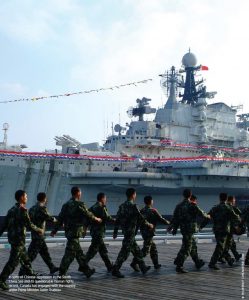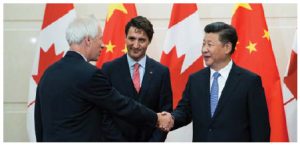
During the 2015 federal elections in Canada, the Liberal Party platform spoke of building up the Canadian middle class. One of the ways it said it would do that was by forging greater trade relations with emerging markets, including China. But, during the Munk Centre foreign policy debate between the Liberal, Conservative and NDP leaders, there were no questions dealing with China.
While there were foreign policy questions to debate about the United States, Syria, Ukraine and others, the lack of any China questions was reportedly due to the fact that all three parties supported increasing trade with China, though each also expressed concerns about its human rights record.
The Trudeau legacy
Following his election win in October, Prime Minister Justin Trudeau began his first round of diplomatic travel as Canadian prime minister by attending the November 2015 G20 Summit in Antalya (Turkey). On the margins of the summit, he met with Chinese President Xi Jinping, who praised the vision of Trudeau’s father, Pierre, who, as prime minister, established diplomatic relations between Canada and the People’s Republic of China in 1970. This leaders’ meeting so early in Trudeau’s mandate was seen as evidence that he would give a priority approach to “deepening Canada’s economic relations in Asia,” and specifically with China.

From then on, there have repeatedly been media reports that the Trudeau government was doing a major review of Canada’s China strategy with regards to political relations and trade policies. During former prime minister Jean Chrétien’s private business visit to Beijing in April, Chinese Premier Li Keqiang stated that Canada-China relations could again be entering a golden era. And this could include talks on a bilateral free-trade agreement and even Canada seeking membership in the newly formed China-led Asian Infrastructure Investment Bank (AIIB) in a second membership round.
A disastrous press conference
In June, Chinese Foreign Minister Wang Yi made an official — though on short notice — visit to Ottawa. He stated that Canada and China were headed for a “new golden age” in country-to-country relations. He also referred to Pierre Trudeau as a friend of China for establishing those early diplomatic ties, and noted the gains made by former Liberal prime ministers Jean Chrétien and Paul Martin. But he made no mention of former Conservative prime minister Stephen Harper, who, during his near decade in power, was seen as having cooler relations with China. Harper did make a state visit to China in 2012 when he signed a Foreign Investment and Protection Agreement (FIPA) — though his government only ratified this FIPA accord in September 2014.
Following their private talks in the previously unannounced initial Canada-China Foreign Affairs Ministers’ Dialogue, Foreign Minister Wang and Foreign Minister Stéphane Dion held a joint press conference at Global Affairs Canada’s Lester B. Pearson Building.
Unfortunately, following a Canadian media question to Dion, Wang made an angry outburst criticizing the Canadian reporter who had asked the agreed pool question on human rights in China, the detention of Canadian Ken Garratt and Chinese activities in the South China Sea. He stated in the press conference that the reporter was “irresponsible” and said her question was “full of prejudice against China and arrogance.” After the press conference — reportedly at Wang’s insistence and in a breach of diplomatic protocol for meeting a head of government — Wang had a meeting and photo opportunity with Trudeau at his parliamentary office.
This public Chinese criticism of a Canadian journalist doing her job of asking serious questions — though limited to one pool question and one secondary question — resulted in a nationwide rebuke for the Chinese foreign minister’s disrespect for Canadian democratic practices, principles of freedom of the press and the Canadian people in general.
Questioned later about Wang’s disastrous press conference, Trudeau offered a weak public response that his government had made Canada’s “dissatisfaction” over Wang’s outburst known to China. Within days, Chinese Ambassador Luo Zhaohui issued a press release further talking about a new “golden era” in China-Canada relations and stated that Canada should not be “blinded” over human rights differences with China. Even the Chinese foreign ministry in Beijing issued a press release that stated there was “nothing more to add.”
Ministerial mandate letters
Following his majority election win, Prime Minister Trudeau issued ministerial mandate letters with his expectations for each assigned portfolio. He designated Stéphane Dion as foreign minister in the newly renamed Global Affairs Canada — formerly the Department of Foreign Affairs, Trade and Development. As part of Trudeau’s foreign affairs political team, Chrystia Freeland was named minister of international trade. Despite the setting out of specific policy guidelines in these made-public mandate letters, there was little mention of China. The foreign affairs mandate letter called for a restoration of “constructive Canadian leadership in the world and to advance Canada’s interests.” It only specifically mentioned the United States. In the international trade mandate letter, the main goal was to “increase Canada’s trade and attract job-creating investment to Canada, focusing on expanding trade with large, fast-growing markets, including China and India, and deepening our trade links with traditional partners.”
Prospects for a free-trade agreement
In a January interview with the Globe and Mail in Ottawa, Han Jun, China’s vice-minister of financial and economic affairs, stated: “If there is an FTA arrangement between China and Canada, you can see a flooding of potash, agricultural products and energy products from Canada to the market of China.” However, Han said, China had its own demands, namely the removal of restrictions put in place by the former Conservative government on Chinese state-owned investments in Canada’s oil and gas sector and a commitment to build an energy pipeline from the Alberta oil fields to the Pacific Coast.
In 2015, Australia and China signed an FTA that had taken 10 years to negotiate, but gave China wider access to Australia’s mineral deposits and other natural resources. With suggestions that a Canada-China accord could be patterned on the Australian agreement, the Canada- China Business Council has estimated a free-trade agreement could double Canadian exports to China by 2030 and create an additional 25,000 Canadian jobs. But Chinese state-owned enterprises (SOEs) are a special concern as their policies and actions — unlike private corporations that are seeking profitability — can have profit-related and political objectives.
Not surprisingly, in the aftermath of the Chinese foreign minister’s outburst, Trudeau stated in a June 20 Vancouver Sun interview: “I don’t think an FTA with China is something to rush” during his current term, which goes to 2019.
Canadians’ view of China trade
In an October 2015 Asia Pacific Foundation of Canada (APFC) national opinion poll on the Trans-Pacific Partnership and free trade agreements, a majority of Canadian respondents were against a free-trade agreement with China, with 48 per cent opposed and 42 per cent in support. Similarly, a February 2016 NANOS-Globe and Mail poll noted that Canadians have a very negative impression of the Chinese government and were narrowly opposed to a free-trade deal. In that poll, 76 per cent had a negative or somewhat negative view of the government of China, compared with only two per cent positive and nine per cent somewhat positive views. On the issue of a free-trade agreement, Canadian public opinion was narrower, with 47 per cent opposed or somewhat opposed and 41 per cent in support or somewhat in support.
These poll results suggest the Trudeau government will need to convince the Canadian public that such trade agreements with China will not lead to cuts in Canadian jobs, as well as undercut national intellectual property rights and environmental standards.
Yet, in a June 2016 C-Suite Survey quarterly of the views of Canadian corporate leaders, more than half surveyed wanted trade with China broadened and felt that Canada’s current trade relationship was too restrictive. And 78 per cent would support a free-trade agreement with China if it were negotiated in the next five years.
The way forward
In the months since, Trudeau’s Liberal government reportedly began a Canada-China policy review behind closed ministry doors. Over the same period, academics, journalists, think-tanks, lobbying groups and others have publicly offered a variety of policy options and recommendations.
But there is a major dilemma for this China policy review, namely that there has been a continuing decline in the Canadian public’s views on China’s political leadership, particularly since June’s public outburst by the Chinese foreign minister. Despite these continuing negative views, Canadian business leaders still are seeking to broaden trade relations with China, even calling for the start of FTA talks.
Nevertheless, as founding APFC president John Bruk has pointed out in an online opinion piece (OpenCanada.org, June 15, 2016), this China policy dilemma would suggest the need for a national debate on the way forward.
Postscript
Prior to attending the G20 Summit in Hangzhou, China, in September, Trudeau made a five-day state visit to Beijing and Shanghai, including a family stroll (his wife Sophie and their daughter, Ella, were with him) and photo-op on the Great Wall of China. After the summit meeting, he also visited Hong Kong. Reportedly, Chinese foreign minister Wang’s June visit had been to help prepare for the visits between Chinese and Canadian leaders before the end of this year. Chinese Premier Li Keqiang is also expected to make a working visit to Canada in mid-September.
Prior to the G20 summit, Trudeau announced the signing of 56 trade deals with China worth $1.2 billion ($980 million US) and that Canada would be applying for membership in the China-led Asian Infrastructure Investment Bank (AIIB).
The AIIB governors’ board is likely to decide on new members in early 2017, and the size of Canada’s investment share would be decided at that time. In addition, Trudeau and Premier Li reached a last-minute temporary halt to China’s decision to block Canadian canola shipments over its demand for only one per cent dockage (foreign matter), down from the current 2.5 per cent. China is Canada’s largest canola buyer. With totals estimated at $2 billion in export earnings, 87 per cent of China’s total canola oilseed imports come from Canadian farmers.
On the prospects for a Canada-China FTA, Premier Li is reported to have stated that there was agreement on the need to launch feasibility studies on such an agreement “at an early date.” But Guy Saint-Jacques, Canada’s ambassador to China, noted that “there’s no agreement to proceed with exploratory talks” on an FTA at this time as there were Canadian concerns about labour and environmental issues as well as the role of Chinese state-owned enterprises (SOEs).
Robert D’A. Henderson is a retired professor of international relations who currently does international assessments and international elections monitoring. Among his recent writings is “China — Great Power Rising,” in the Routledge Handbook of Diplomacy and Statecraft (London and New York).






